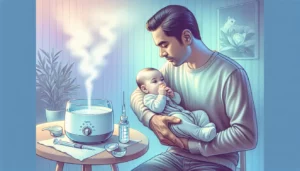Home Remedies for Diverticulitis: Your Guide to Natural Relief in 2025
Estimated reading time: 8 minutes
Key Takeaways
- Dietary shifts like clear liquids during flare-ups and high-fiber foods for prevention can ease diverticulitis symptoms.
- Hydration is critical—aim for 8-10 cups of water daily to support digestive health.
- Natural pain relief, such as heat therapy, offers comfort for mild abdominal discomfort.
- Lifestyle changes, including exercise and stress reduction, help prevent future flare-ups.
- Always consult a doctor for severe symptoms or complications; home remedies have limits.
Table of Contents
- Introduction to Diverticulitis and Home Remedies
- What Is Diverticulitis? A Quick Overview
- Causes and Triggers of Diverticulitis Flare-Ups
- When to Seek Medical Help: Red Flags to Watch For
- Effective Home Remedies for Diverticulitis Symptom Relief
- Lifestyle Changes for Long-Term Gut Health
- Safety and Limitations of Home Remedies
- Frequently Asked Questions (FAQs) About Diverticulitis Remedies
- Tools and Resources for Managing Diverticulitis
Introduction to Diverticulitis and Home Remedies
Navigating the discomfort of diverticulitis can feel overwhelming, but you’re not alone in seeking natural ways to ease the pain. Diverticulitis is a condition where small pouches, called diverticula, in your digestive tract become inflamed or infected, often causing sharp abdominal pain, fever, or nausea. Many turn to home remedies for gentle support, especially during mild flare-ups or recovery phases, as a way to complement medical care.
At WikiHomeRemedies, we’re dedicated to guiding you with trustworthy, scientifically grounded advice. Drawing from reputable sources like the Mayo Clinic, we understand that diverticulitis affects millions, and natural solutions can play a vital role in managing symptoms. Our mission is to help you harness nature’s healing potential safely. Let’s explore what this condition entails and how you can find relief through simple, everyday practices.
What Is Diverticulitis? A Quick Overview
Diverticulitis starts with the formation of tiny pouches in the colon wall, known as diverticula, which can become irritated or infected. This often happens over time, particularly in older adults, and can lead to significant discomfort. While many people with diverticula remain symptom-free, an estimated 10-25% develop diverticulitis, according to the National Institutes of Health (NIH).
The symptoms can catch you off guard. They often include:
- Persistent pain, usually in the lower left abdomen.
- Bloating or a feeling of fullness.
- Changes in bowel habits, like constipation or diarrhea.
- Occasional fever or nausea.
Certain factors raise the risk, such as advancing age or a diet lacking fiber. If left unmanaged, complications like abscesses might arise, making it crucial to pay attention to your body. Understanding this condition is the first step toward finding relief and preventing future issues.
Causes and Triggers of Diverticulitis Flare-Ups
The roots of diverticulitis often lie in lifestyle and biology. A diet low in fiber can weaken the colon wall over years, allowing diverticula to form and sometimes inflame, as noted by the Mayo Clinic. Aging and family history also play a part, subtly shifting the odds against digestive harmony.
Flare-ups, those sudden waves of pain, often stem from specific triggers. Recognizing what sparks your symptoms can be a game-changer. Common culprits include:
- Stress that tightens your body and disrupts gut balance.
- Dehydration, making digestion harder on your system.
- Diets heavy in processed foods or lacking roughage.
- Sedentary habits that slow down bowel movement.
Harvard Health points to lifestyle as a key player in these episodes. By pinpointing your personal triggers, whether it’s a hectic week or skipping meals, you can take control. This awareness sets the foundation for natural strategies to soothe and protect your gut.
When to Seek Medical Help: Red Flags to Watch For
Home remedies offer comfort, but they’re not a replacement for professional care when diverticulitis turns severe. Your safety comes first, and knowing when to reach out to a doctor can make all the difference. Trust your instincts if something feels off beyond mild discomfort.
Watch for these warning signs that signal the need for immediate medical attention:
- Intense abdominal pain that doesn’t ease up.
- A fever climbing above 100.4°F (38°C).
- Visible blood in your stool or rectal bleeding.
- Vomiting that persists or worsens.
The Cleveland Clinic emphasizes that these symptoms could point to complications like perforation or infection. Don’t hesitate to consult your healthcare provider, even if you’re unsure. Pairing natural approaches with medical guidance ensures you’re on the safest path to recovery.
Effective Home Remedies for Diverticulitis Symptom Relief
Finding natural ways to ease diverticulitis symptoms can bring welcome relief during tough moments. These remedies focus on supporting your body’s healing process through diet, hydration, and gentle care. Backed by insights from WebMD and Harvard Health, let’s explore practical steps you can take at home to feel better.
Dietary Adjustments During and After Flare-Ups
Your diet holds immense power in managing diverticulitis, especially during and after a flare-up. When pain strikes, ease the burden on your gut with a clear liquid diet for a day or two—think broth, clear juices, or gelatin. The Mayo Clinic suggests this helps your colon rest while inflammation calms down.
As symptoms lessen, transition to low-fiber foods like white rice or bananas for a gentle reintroduction. Once you’re past the acute phase, aim for a high-fiber diet with 25-30 grams daily through oats, apples, or broccoli to prevent future issues. Avoid processed snacks, fatty meats, or spicy dishes that might irritate your system. Contrary to old myths, the Cleveland Clinic confirms nuts and seeds are generally safe for most. Listen to your body and adjust slowly for the best results, pairing these choices with other supportive habits. For more on managing digestive discomfort through diet, check out related advice on stomach issues at WikiHomeRemedies.
Hydration for Digestive Health
Water is a quiet hero for your digestive system when dealing with diverticulitis. Staying hydrated softens stool and eases strain on your colon, reducing the risk of irritation. WebMD highlights that proper fluid intake is essential for keeping things moving smoothly.
Aim for 8-10 cups (about 2-2.5 liters) of water each day, more if you’re active. Foods like watermelon or cucumber can also boost your hydration while adding variety. Sip consistently rather than gulping large amounts at once to support your gut. This simple habit works hand-in-hand with dietary changes, creating a foundation for less discomfort and better recovery.
Natural Pain Relief Techniques
Easing abdominal pain naturally can make flare-ups more bearable without overloading on medication. Heat therapy stands out as a go-to method—place a heating pad on your lower abdomen for 15-20 minutes. Medical News Today notes this can relax muscles and dull the ache.
Rest is just as vital; lie down and let your body reset. Pair this with calming practices like deep breathing or a short meditation to melt away tension. These steps won’t cure the condition, but they offer a moment of peace. Over time, weaving in stress relief can lessen the frequency of painful episodes, supporting your overall well-being.
Herbal and Natural Supplements
Nature offers subtle aids for gut health, though they require caution. Aloe vera juice, known for its soothing properties, may help calm inflammation in small doses. Probiotics, found in yogurt or supplements, could also nurture a healthier digestive balance, as Healthline suggests.
Before trying these, speak with your doctor to avoid clashes with any medications. Not all herbal options are backed by robust research, so tread carefully. Used wisely, these additions might enhance your remedy toolkit, working alongside diet and lifestyle tweaks for a fuller approach to relief. For additional insights on managing gut inflammation naturally, explore remedies for related digestive conditions at WikiHomeRemedies.
Lifestyle Changes for Long-Term Gut Health
Beyond immediate relief, building habits for lasting gut health can keep diverticulitis at bay. Small, steady changes in how you live day-to-day protect your digestive system and cut the risk of flare-ups. Let’s walk through practical shifts, grounded in insights from Johns Hopkins Medicine and Harvard Health, to support your journey.
Gradual Exercise for Digestive Support
Moving your body, even lightly, can do wonders for bowel regularity. Start with a 20-minute walk each day or simple yoga poses like a gentle twist to stimulate digestion. Johns Hopkins Medicine points out that such activity helps your colon function without strain.
Don’t push too hard—ease into it if you’ve been sedentary. Consistency matters more than intensity. Over weeks, this habit not only aids your gut but lifts your overall energy, creating a cycle of wellness that guards against future discomfort.
Stress Reduction Strategies
Stress can silently fuel diverticulitis flare-ups by unsettling your gut. Carving out time for mindfulness, even five minutes of focused breathing, can reset your nervous system. Medical News Today connects lower stress levels to better digestive health.
Try journaling your thoughts at day’s end to offload worries. These quiet practices ground you, cutting the tension that might trigger pain. With regular effort, you’ll notice a calmer mind and a happier gut working in tandem. For more techniques on reducing stress-related health issues, see WikiHomeRemedies.
Weight Management and Its Benefits
Carrying extra weight can add pressure to your digestive tract, worsening diverticulitis risks. Focusing on balanced meals with fiber-rich vegetables and lean proteins helps maintain a healthy range. Harvard Health links steady weight control to fewer gut complications.
No crash diets needed—just mindful portions and whole foods. Shedding even a small percentage of excess weight can lighten the load on your colon. This step, paired with movement, builds a stronger foundation for long-term ease.
Safety and Limitations of Home Remedies
While natural approaches bring comfort, they have boundaries when it comes to diverticulitis. These remedies support mild symptoms or recovery but can’t tackle severe cases or complications like infections. Everyday Health warns that relying solely on home care risks delaying critical treatment.
Be mindful of signs that persist or worsen, such as unrelenting pain or fever. Avoid untested treatments floating around online—stick to proven ideas and always check with your doctor. Some risks to note include:
- Overusing supplements that might irritate your gut.
- Ignoring symptoms hoping they’ll vanish on their own.
Personalized medical advice remains key. Your healthcare provider can tailor a plan that blends natural steps with necessary interventions. This balance keeps you safe while exploring nature’s support.
Frequently Asked Questions (FAQs) About Diverticulitis Remedies
Wondering about the ins and outs of managing diverticulitis naturally? Let’s address some common questions to clear up doubts and guide you further, drawing from trusted sources like the Mayo Clinic.
Can certain foods cure diverticulitis? No food acts as a direct cure, but specific choices manage symptoms well. A high-fiber diet prevents issues long-term, while liquids during flare-ups rest your gut, as the Mayo Clinic advises. Focus on support, not a fix.
How long should I follow a low-fiber diet during a flare-up? Typically, stick to it for 2-3 days until pain subsides, then gradually reintroduce fiber. A doctor can confirm the right timeline for your situation to avoid straining your system.
Are probiotics safe for diverticulitis? They can be beneficial for gut balance, per Verywell Health, but check with your provider first. Some may experience bloating if introduced too quickly.
Can stress cause a flare-up? Yes, it’s often a trigger due to its impact on digestion, notes Medical News Today. Managing stress through simple techniques can lower this risk over time.
These answers aim to ease lingering concerns, ensuring you feel informed and supported.
Tools and Resources for Managing Diverticulitis
Empowering yourself with knowledge and community can make managing diverticulitis less daunting. Beyond the remedies shared, tapping into reliable resources offers deeper insight and emotional backing. WikiHomeRemedies encourages connecting with trusted information for your peace of mind.
Consider exploring these supports:
- The National Institutes of Health (NIH) for detailed studies on digestive health.
- Mayo Clinic’s comprehensive guides on diverticulitis care and prevention.
- Online forums or local groups for shared experiences and encouragement.
These tools extend the guidance we’ve provided, helping with both practical steps and a sense of connection. Dive into them to enrich your path toward natural relief and sustained wellness. For additional digestive health tips, you might find useful information at WikiHomeRemedies.










